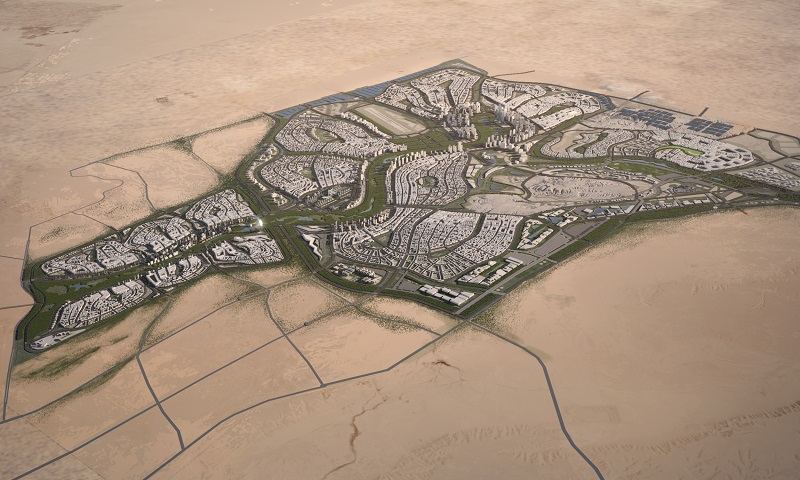Egypt is building a capital from scratch in the desert
Sentinel-1 CSAR IW acquired on 09 October 2014 at 15:56:09 UTC
Sentinel-2 MSI acquired on 03 August 2015 at 08:41:36 UTC
...
Sentinel-1 CSAR IW acquired on 27 June 2019 at 15:55:49 UTC
Sentinel-2 MSI acquired on 08 July 2019 at 08:26:09 UTC
Sentinel-2 MSI acquired on 03 August 2015 at 08:41:36 UTC
...
Sentinel-1 CSAR IW acquired on 27 June 2019 at 15:55:49 UTC
Sentinel-2 MSI acquired on 08 July 2019 at 08:26:09 UTC
Keyword(s): Land, urban planning, desert, infrastructures, renewable energy, Nile valley, Egypt.
With its demographic growth, Egypt gains two millions inhabitants each year, it making necesssary to extend cities out of the 7% of the land that is currently inhabited. With a population of over 9 million spread over 3085 km², Cairo is by far the largest city in Egypt. An additional 9.5 million inhabitants live in close proximity to the city. Cairo, like many other megacities, suffers from high levels of pollution and traffic.
To alleviate Cairo from these issues, the Egyptian minister of housing ,utilities & urban communities Mostafa Madbouly announced the contruction of a new administrative capital: "This project aims to develop Cairo as a leading political, cultural and economic center for the Middle East and North Africa region through a thriving economic environment supported by diversified economic activities and sustainable development to ensure the preservation of Cairo's historic and natural assets and to facilitate its living through an efficient infrastructure."
"An area of [714 km²] has been allocated to establish the administrative capital of Egypt in a privileged position east of the city of Cairo, close to the Suez Canal area and regional roads and major axes. The target population during the first phase is about 5 million persons. 40 to 50 thousand government employees will be transferred to the new siege, with the goal to increase the capacity to 100 thousand employees after the first three years."

Plans of Wedian Green City - Source: Urban Development Consortium
The project, named Wedian Green City by its promoter Urban Development Consortium, nicknamed Sisi-City by some in the population (referring to the current Egyptian president Abdel Fattah el-Sisi), is described by them in the following words: "[714 km²] for 15 million people. This new city will be the Egyptian Government’s new administrative capital. This mega sized project will include Egypt’s largest public park spanning [8.4 km²] along 35 kilometres of the city’s spine. 'Wedian' is the plural word for 'Wady' which translates to 'Valley', this project was named as such due to its consisting of 12 distinct valleys that will serve as hubs for different sectors."
Additional details are provided in a article written in 2015 by the BBC: "Housing Minister Mostafa Madbouly said the project would cost $45bn and take five to seven years to complete. He said the aim was to ease congestion and overpopulation in Cairo over the next 40 years. The gathering, in the Red Sea resort of Sharm el-Sheikh, has attracted pledges worth $12bn in aid and investment from Kuwait, Saudi Arabia and the United Arab Emirates."
"The Egyptian parliament and its government departments and ministries, as well as foreign embassies, would move to the new metropolis, he said. Developers say the new city - the name of which has not been revealed - would include almost 2000 schools and colleges and more than 600 health care facilities. They say the project will create more than a million jobs."
Orla Guerin, BBC Cairo Correspondent, provides the following analysis: "If and when it's completed - and that could take years - it will be about the size of Singapore, with an airport larger than Heathrow. The idea is to lure Egyptians away from the chaotic sprawl of Cairo - where congestion and pollution seem as constant as the waters of the Nile. The authorities say it will spark a renaissance in the economy. Perhaps, but many here recall other flagship projects - which stalled in the past. Egyptian bureaucracy can be as enduring as the pyramids."
Egypt has several examples of such cities built from nothing after a political decision. Located on the left third of the image above, New Cairo is a city located east of Cairo and west of the new administrative capital, covering an area of about 300 km². New Cairo is one of the new cities which have been built in and around Cairo to alleviate the congestion in downtown Cairo. Price of the new housing is usually what makes the success or the failure of such projects: the city could eventually host a population of 5 million but currently counts 200 000 inhabitants.
10th of Ramadan is a city built north-east of Cairo after a presidential decree in 1977. This decision was based on the bet to attract foreign and local capital with the intent of providing job opportunities for the country's youth as well as move people away from the Nile Valley to ease the stress on existing infrastructure and reduce congestion. Its population now reaches around 500 000 inhabitants.
6th of October city was built south-west of Cairo after a similar decree. It has a total area of 482 km² and, eventually, is expected to reach 6 million inhabitants, although there are many unoccupied or incomplete buildings. It has a population ranging between some 185 000 in the city to an estimated 500 000 inhabitants in the wider area.
When compared to New Cairo, also built with the hopes of alleviating the strain on Cairo, more homes are being rented out in New Cairo than in 6th of October.















